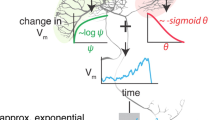Abstract
Virtually from its origins, with Turing and McCulloch’s formulations, the use of the computational paradigm as a conceptual and theoretical framework to explain neurophysiology and cognition has aroused controversy. Some of the objections raised, relating to its constitutive and formal limitations, still prevail. We believe that others stem from the assumption that its objectives are different from those of a methodological approximation to the problem of knowing.
In this work we start from the hypothesis that it is useful to look at the neuronal circuits assuming that they are the neurophysiological support of a calculus, whose full description requires considering three nested levels of organization, one of circuits, other of neurophysiological symbols and another of knowledge, and two description domains, the intrinsic to each level and that of the external observer.
Preview
Unable to display preview. Download preview PDF.
Similar content being viewed by others
References
Clancey, W.J.: Situated cognition. On human knowledge and computer representation. Univ. Press, Cambridge (1997)
Craik, K.: The Nature of Explanation. Cambridge University Press, Cambridge (1943)
Dayan, P., Abbott, L.F.: Theoretical Neuroscience. The MIT Press, Cambridge (2001)
Edelman, G.M.: Neural Darwinism. Basic Books, Inc., N. York (1987)
Fodor, J.A.: El Lenguaje del Pensamiento. Alianza Editorial, Madrid (1984)
Kleene, S.C.: Representation of events in nerve nets and finite automata. In: Shannon, McCarty, J. (eds.) Automata Studies, pp. 3–42. Princeton Univ. Press., Princenton (1956)
Kuhn, T.S.: La Estructura de las Revoluciones Científicas. Fondo de Cultura EconómicaFondo de Cultura Económica., México (1971)
Marr, D.: Vision. Freeman, New York (1982)
Maturana, H.: Ontology of observing. the biological foundations of self consciousness and the physical domain existence (2002), http://www.inteco.cl/biology/ontology/
Maturana, H.R.: The organization of the living: A theory of the living organization. Int. J. Man-Machine Studies 7, 313–332 (1975)
Maturana, H.R., Varela, F.: El Árbol del Conocimiento Humano. Ed. Debate, Madrid (1990)
McCulloch, W.S.: Embodiments of Mind. The MIT Press, Cambridge, Mass (1965)
McCulloch, W.S., Pitts, W.: A logical calculus of the ideas immanent in nervous activity. Bulletin of Mathematical Biophysics 5, 115–133 (1943)
Mira, J.: Reverse neurophysiology: The embodiments of mind revisited. In: Moreno-Díaz, R., Mira-Mira, J. (eds.) Brain Processes, Theories and Models, pp. 37–49. The MIT Press, Massachusetts (1995)
Mira, J., Delgado, A.E.: Some comments on the antropocentric viewpoint in the neurocybernetic methodology. In: Proc of the Seventh International Congress of Cybernetics and Systems, pp. 891–895 (1987)
Mira, J., Delgado, A.E.: Neural modeling in cerebral dynamics. BioSystems 71, 133–144 (2003)
Mira, J., Delgado, A.E.: Where is knowledge in robotics? some methodological issues on symbolic and connectionist perspectives of ai. In: Zhou, C., Maravall, D., Rua, D. (eds.) Autonomous robotic systems, p. 334. Physical-Verlag. Springer, Berlin (2003)
Mira, J., Delgado, A.E., Boticario, J.G., Díez, F.J.: Aspectos básicos de la inteligencia artificial. Sanz y Torres, SL, Madrid (1995)
Montserrat, J.: La Percepción Visual. Ed Biblioteca Nueva, Madrid (1998)
Newell, A.: The knowledge level. AI Magazine 120 (1981)
Newell, A., Simon, H.A.: Computer science as empirical inquiry: Symbols and search. Communications of ACM 19, 113–126 (1976)
Pylyshyn, S.W.: Computation and Cognition. Towards a Foundation of Cognitive Science. The MIT Press, Cambridge (1986)
Moreno-Diaz, R.: Deterministic and probabilistic neural nets with loops. Mathematical Biosciences 11, 129–136 (1971)
Brooks, R.: Intelligence without reason. A.i. memo, MIT, N°. 1293 (1991)
Schreiber, G., Akkermans, H., de Anjo Anjewierden, R.: Engineering and Managing Knowledge: The CommonKADS Methodology. The MIT Press, Cambridge (1999)
Shepherd, G.M. (ed.): The Synaptic Organization of the Brain. Oxford University Press, Oxford (1990)
Varela, F.J.: Principles of Biological Autonomy. The North Holland Series in General Systems Research, New York (1979)
von Foester, H.: Understanding Understanding. Springer, Heidelberg (2003)
von Neumann, J.: Probabilistic logics and the synthesis of reliable organisms from unreliable components. In: Shannon, McCarthy (eds.) Automata Studies. Princenton Univ. Press., Princenton (1956)
Wiener, N.: Cybernetics. The Technology Press. J. Wiley & Sons, New York (1948)
Author information
Authors and Affiliations
Editor information
Editors and Affiliations
Rights and permissions
Copyright information
© 2005 Springer-Verlag Berlin Heidelberg
About this paper
Cite this paper
Mira, J.M. (2005). On the Use of the Computational Paradigm in Neurophysiology and Cognitive Science. In: Mira, J., Álvarez, J.R. (eds) Mechanisms, Symbols, and Models Underlying Cognition. IWINAC 2005. Lecture Notes in Computer Science, vol 3561. Springer, Berlin, Heidelberg. https://doi.org/10.1007/11499220_1
Download citation
DOI: https://doi.org/10.1007/11499220_1
Publisher Name: Springer, Berlin, Heidelberg
Print ISBN: 978-3-540-26298-5
Online ISBN: 978-3-540-31672-5
eBook Packages: Computer ScienceComputer Science (R0)




